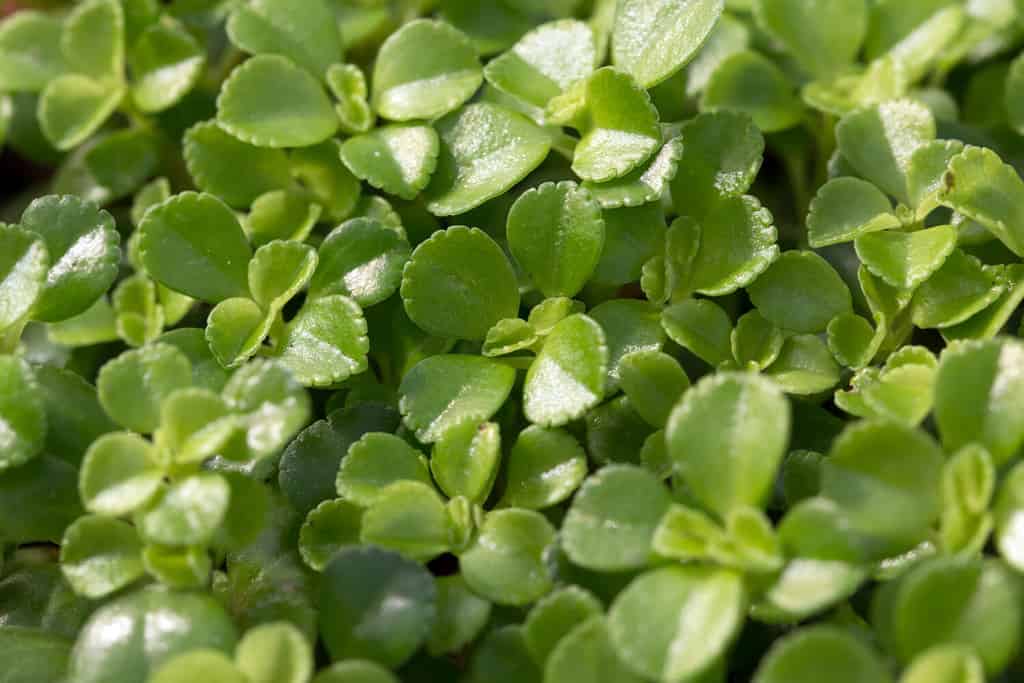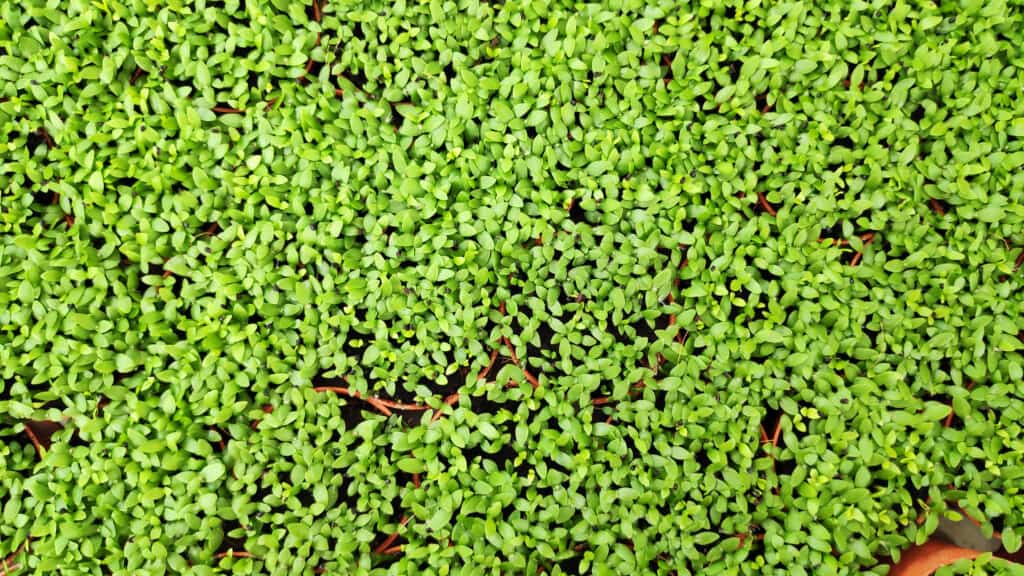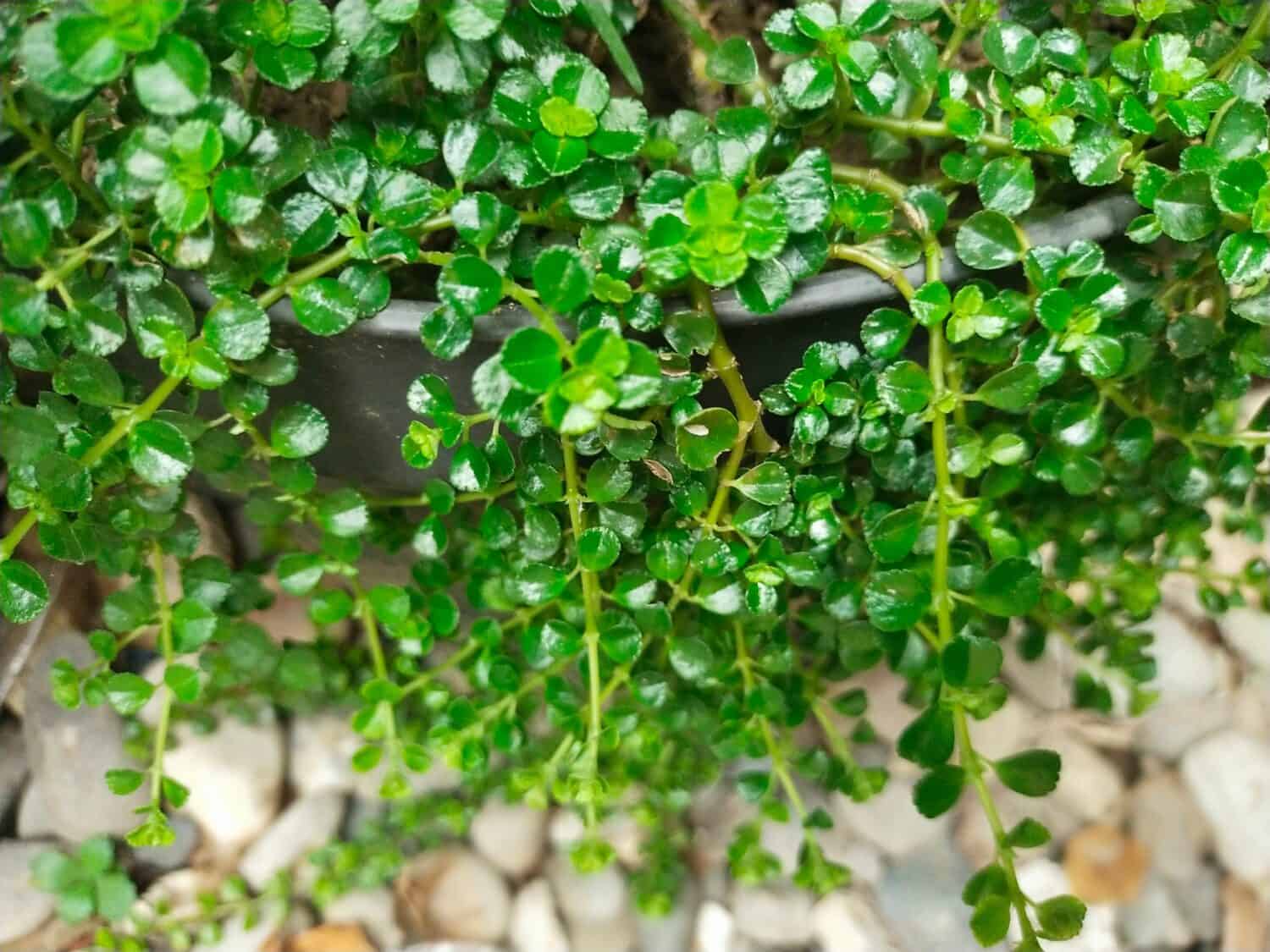A lush, green lawn is a right of passage for homeowners, offering a picturesque setting for outdoor activities like family barbecues and enhancing the curb appeal of your property. However, maintaining a pristine lawn is not always a walk in the park, especially when unexpected challenges like baby’s tears spring up. Baby’s tears, a resilient ground cover with an adorable name, quickly invade turfgrass. Discover the steps to grow and maintain a beautiful lawn but also control and combat the presence of baby’s tears. Your dream of a vibrant, weed-free turf is well within reach.
What Are Baby’s Tears?
Scientifically known as Soleirolia soleirolii, baby’s tears is a low-growing, creeping perennial plant. It goes by many names, including angel’s tears and mind-your-own-business plant. This ground cover produces tiny, bright green leaves that resemble drops of water. Additionally, its leaves form dense, lush mats that spread quickly. They are often a popular choice for ground covering in shady, moist areas.
While some homeowners grow baby’s tears on purpose, especially in controlled garden areas or indoors, they are also invasive and crowd other plants when mismanaged.
How Do Baby’s Tears Affect Your Lawn?
Depending on their management, baby’s tears can have both positive and negative effects on your lawn.

While baby’s tears create a lush, carpet-like appearance in your garden, proper care and control measures are essential to prevent them from overtaking your plants and landscape.
©Skyprayer2005/Shutterstock.com
Aesthetics
The bright green perennial creates a lush, carpet-like appearance in your lawn that adds an appealing touch. Their tiny leaves look like water droplets, giving landscape areas a unique texture. But, if left uncontrolled, the baby’s tears spread rapidly and create a thick ground cover that appears messy, overcrowded, and unkempt.
Weed Suppression
Baby’s tears suppress weed growth in lawns thanks to their dense, matting growth habit. This also reduces your need for chemical weed control and makes your lawn more manageable. However, if the baby’s tears spread too aggressively, they become a weed that competes with your turfgrass.
Moisture Retention
The dense growth of the mind-your-own-business plant helps retain soil moisture, which is also beneficial for your turfgrass, especially in dry conditions. Unfortunately, excessive moisture leads to other problems like fungal diseases and is detrimental to your lawn’s health.
Shade Tolerance
Baby’s tears thrive in shaded areas, making them an excellent choice for areas of your lawn with limited sunlight. However, they can encroach on sunny areas and cause an imbalance in your lawn’s composition and aesthetics.
Growing a Healthy Lawn in the Presence of Baby’s Tears
Most homeowners do not welcome the sight of a baby’s tears. The key to a beautiful and thriving landscape is routine maintenance that addresses your turfgrass and also the challenges posed by the persistent and fast-growing perennial.
Soil Preparation
The first step is to understand your soil as well as the preferences of baby’s tears so you can create a favorable environment for your turfgrass while simultaneously creating an unfavorable one for the ground cover.
Send a soil sample to your local agricultural extension office for testing. Baby’s tears grow best in acidic to neutral soils or a pH between 5.5 and 7. Unfortunately, the optimal range for both warm-season and cool-season grass types is also between 6 to 7. Aim to add soil amendments to address the needs of your turfgrass. Adjust your soil’s pH to meet the higher range and eliminate the more acidic conditions preferred by baby’s tears.
Pro tip: Baby’s tears also thrive in moist soil. Combat the pest by ensuring your lawn has adequate drainage.
Grass Compatibility
Certain grass types are more tolerant, growing alongside pests like baby’s tears. Additionally, other grass types are more shade-tolerant, making them a great alternative to the shade-loving ground cover. Here are some common grass varieties that thrive in place of baby’s tears:
- Fine fescue: Fine fescue varieties like creeping red fescue and chewings fescue have high shade tolerance, making them a great choice to grow in shady areas where baby’s tears thrive.
- Perennial ryegrass: Often used for overseeding, this cool-season cultivar tolerates some shade. It is also incredibly fast-growing and a great option for seeding areas overrun with baby’s tears. Its fast growth can overtake the ground cover and help blend areas of your landscape.
- St. Austine grass: This warm-season grass has some shade tolerance and can grow in place of the ground cover in shady areas.
Mowing
Baby’s tears tend to spread horizontally, creating a dense mat. To maintain a well-manicured lawn, adopt a regular mowing and pruning schedule. Adjust the height of your mower blades depending on your grass type.
Cool-season grasses like Kentucky bluegrass prefer mow heights of 2.5 to 3.5 inches, while warm-season grasses like Bermuda grass prefer heights of around 1 to 2 inches. Additionally, avoid cutting more than one-third of the grass blade’s height in a single mowing session. This practice helps prevent stress on the grass and promotes healthy growth.
Pro tip: Vary your mowing direction each session to prevent your grass from leaning in one direction. This encourages upright growth and helps disguise the baby’s tears.
Proper Watering Techniques
Baby’s tears thrive in moist areas, and overwatering can encourage their rapid growth. It also leads to issues like waterlogging. Employ smart watering practices, such as deep, infrequent watering early in the morning, to maintain a healthy balance.
Pro tip: Water your lawn between 6 a.m. to 10 a.m. for 15 minutes three times per week.

Grow baby’s tears indoors to enhance indoor air quality. They are also visually appealing and beneficial to your home’s atmosphere.
©Tang Yan Song/Shutterstock.com
How to Control Baby’s Tears on Your Lawn
Controlling baby’s tears in your lawn requires patience and persistence. It also requires a combination of strategies to manage and reduce their presence. Follow a few simple steps to help control baby’s tears:
- Manual removal: Begin by hand pulling the baby’s tears. Carefully pull or dig them out, including their roots. This is an effective approach when your infestation is limited to specific areas.
- Lay mulch: Apply a thick layer of organic mulch, such as wood chips or bark, to areas where the baby’s tears are problematic. This can help smother and suppress their growth.
- Edge: Maintain well-defined edges between your lawn and garden beds to prevent the ground cover from encroaching into your lawn.
- Mow: Mow your lawn regularly and at the appropriate height for your grass type. This will help keep the baby’s tears in check and encourage grass growth.
- Modify your techniques: Adjust your lawn care practices to favor grass over the shade-loving perennial. Adjust your fertilization and watering routines to meet the needs of your grass while making the environment less hospitable for the ground cover plant.
- Use herbicides (as a last resort): Consider using herbicides as a last resort for severe infestations. Choose a selective herbicide that targets broadleaf weeds but does not harm your grass. Follow the manufacturer’s instructions carefully, and use herbicides sparingly and with caution.
Pro tip: If your baby’s tears problem is persistent and difficult to control, consider consulting with a local professional for expert advice and solutions.
Maintenance Tips
Maintaining a healthy lawn with baby’s tears in the mix requires specific maintenance practices. Here are some essential maintenance tips to keep your lawn in great shape while managing the presence of the ground cover:
- Raise your mower height: Mow your lawn regularly, but consider adjusting your mower height to ensure you’re not cutting the grass too short. Shorter grass stresses your turf, giving the baby’s tears a chance to overtake it.
- Skip watering: Skip watering your lawn if the soil is still moist. Moist, waterlogged soil speeds up the growth of baby’s tears.
- Smart fertilization: Use a balanced, slow-release fertilizer with a lower nitrogen content to promote healthy grass growth without excessively stimulating the baby’s tears. Follow the recommended application rates and schedules for your specific grass type.
- Control weeds: Implement effective weed control measures to manage baby’s tears but also other invasive plants. Use selective herbicides if necessary, and spot-treat areas with particularly dense growth.
- Dethatch: Dethatch your lawn to prevent the buildup of organic matter. Thatch creates a favorable environment for baby’s tears and inhibits water and nutrient absorption by your grass.
- Aerate: Aerate your lawn to improve soil compaction and ensure proper air and water penetration.
- Reseed: If the baby’s tears become invasive, consider a lawn renovation project. This includes reseeding or resodding to establish a healthier, more competitive landscape.
Nurture a Thriving Lawn Amidst Baby’s Tears
Maintaining a thriving lawn while managing baby’s tears is no easy task. It requires a balanced approach. While baby’s tears offer a unique appearance, they also present challenges and can overrun your lawn if left unchecked.
To strike a balance between the charm and whimsy of the ground color and your turf grass, it is essential to follow routine lawn maintenance, including watering, mowing, fertilization, and pest control measures. Furthermore, manual removal, mulching, monitoring, and edging aid in the control of the baby’s tears. By carefully implementing maintenance techniques, you can enjoy a thriving turfgrass lawn while maintaining the fast-growing ground cover.
Thank you for reading! Have some feedback for us? Contact the AZ Animals editorial team.








